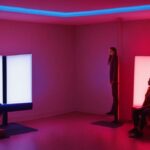Light therapy, also known as phototherapy, is a treatment that employs artificial light to alleviate various health conditions. Many people swear by its benefits, claiming that it can help with Seasonal Affective Disorder (SAD), insomnia, skin problems, and more. But is light therapy good for your health? In this discussion, we will explore the science behind light therapy to understand its potential benefits and risks.
Contents
The Science Behind Light Therapy
Light therapy is a non-invasive treatment that uses specific wavelengths of light to improve mood, sleep, and skin health. The science behind light therapy involves the use of light to activate photoreceptors in the skin and hair follicles. These photoreceptors then trigger a cascade of cellular events that lead to increased blood flow, reduced inflammation, and improved tissue repair.
Different Types of Light Therapy
There are different types of light therapy, including blue light therapy, red light therapy, and green light therapy. Blue light therapy is commonly used to treat acne and other skin conditions. Red light therapy is used to promote collagen production and reduce inflammation, making it an effective treatment for aging skin, wound healing, and joint pain. Green light therapy is used to reduce hyperpigmentation and improve skin texture.
Benefits of Light Therapy
Light therapy has been shown to have numerous health benefits, including:
- Improved mood and cognitive function
- Reduced symptoms of depression and anxiety
- Increased energy and alertness
- Improved sleep quality and duration
- Reduced inflammation and pain
- Improved skin health and appearance
- Reduced symptoms of seasonal affective disorder (SAD)
How to Use Light Therapy
Light therapy can be administered using a light therapy lamp, light therapy box, or light therapy mask. The duration and frequency of light therapy sessions depend on the specific condition being treated and the intensity of the light being used.
Precautions
While light therapy is generally safe, some precautions should be taken to prevent eye damage or skin irritation. It is important to follow the manufacturer’s instructions carefully and avoid looking directly at the light source.
Side Effects
Side effects of light therapy are usually mild and include headache, eye strain, and nausea. These side effects usually go away after a few days of treatment.
Misconceptions About Light Therapy
Despite its numerous health benefits, there are some misconceptions about light therapy. One common misconception is that it can cause skin cancer. However, there is no evidence to suggest that light therapy increases the risk of skin cancer. Another misconception is that it is only effective for treating seasonal affective disorder (SAD). While light therapy is an effective treatment for SAD, it can also be used to treat a variety of other conditions, including acne, joint pain, and skin aging.
Limitations
While light therapy has numerous health benefits, it is not a cure-all and should not be used as a substitute for medical treatment. It is important to speak with a healthcare provider before using light therapy to treat a medical condition.
FAQs – Is Light Therapy Good for Your Health?
What is light therapy?
Light therapy, also known as phototherapy, involves the use of artificial light sources to treat various health conditions such as seasonal affective disorder (SAD), eczema, psoriasis, insomnia, and depression. The therapy involves sitting in front of a light box for a specified period of time, usually between 15 to 60 minutes a day.
How does light therapy work?
Light therapy mimics natural outdoor light that stimulates the brain to produce serotonin, a hormone that regulates mood and sleep patterns. It also suppresses the production of melatonin, a hormone that makes you sleepy. The exposure to light can reset your body clock, improve your mood, and regulate your sleep-wake cycle.
What are the benefits of light therapy?
Light therapy has been shown to be an effective treatment for SAD, a type of depression that affects people during the winter months when there is less sunlight. It can also help improve skin conditions such as eczema and psoriasis by reducing inflammation and increasing circulation. Light therapy has been used to treat sleep disorders such as insomnia by regulating the body’s circadian rhythm. Additionally, it has been used to treat depression and anxiety disorders.
Are there any side effects of light therapy?
Light therapy is generally safe when used properly, but some people may experience side effects such as eyestrain, headache, and nausea. Some individuals may also experience mood swings, agitation, or irritability. It is important to follow the instructions on the light therapy device and to use it under the guidance of a healthcare provider.
Who should not use light therapy?
People with certain medical conditions, such as those taking medications that increase sensitivity to sunlight, or those with bipolar disorder or skin conditions that increase sensitivity to light, should not use light therapy without first consulting with a healthcare provider. Pregnant women should also avoid light therapy as it may affect fetal development.
How can I find the right light therapy product?
It is important to choose a light therapy device that has been certified by a reputable organization, such as the US Food and Drug Administration (FDA) or the Canadian Standards Association (CSA). The device should emit bright, white light, and should have a measured output of at least 10,000 lux. Additionally, it should be easy to use and comfortable to sit in front of for the recommended length of time. Your healthcare provider can also recommend a suitable product.



.jpg)



